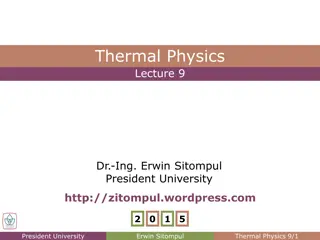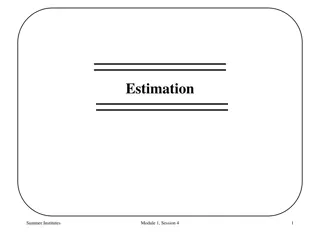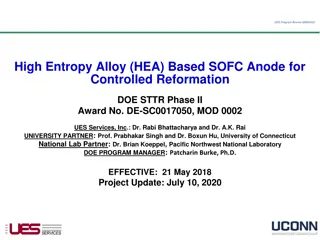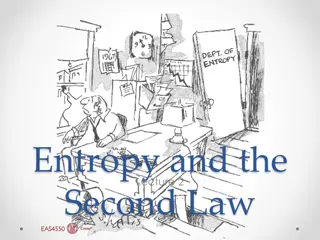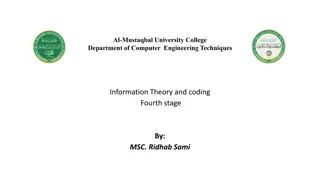Understanding Maximum Entropy Modeling in Environmental Science
Maximum Entropy modeling, also known as MaxEnt, is a technique that maximizes randomness by removing patterns in data. This method is widely used in environmental science to create models using covariates, occurrences, and probability density functions. The relationships between histograms and probability distributions play a key role in determining habitat suitability. The MaxEnt model is based on a log-linear framework and aims to optimize gain, which is related to deviance. Overall, this modeling approach offers a comprehensive understanding of species habitats and environmental predictors.
Download Presentation

Please find below an Image/Link to download the presentation.
The content on the website is provided AS IS for your information and personal use only. It may not be sold, licensed, or shared on other websites without obtaining consent from the author. Download presentation by click this link. If you encounter any issues during the download, it is possible that the publisher has removed the file from their server.
E N D
Presentation Transcript
Maxent Implements Maximum Entropy modeling Entropy = randomness Maximizes randomness by removing patterns The pattern is the response Website with papers: http://www.cs.princeton.edu/~schapire/maxe nt/ namNm15
Overall Definitions Overall area used to create the model: Sample area, area-of-interest (AOI), background Locations where species was observed: Occurrences, presence points, observations Environmental predictors: Covariates, independent variables Probability density function: A function showing the probably of values for a covariate Area under the function must equal 1 namNm15
Definitions ? = sample area (bounds of raster data) ? = vector of covariates (e.g. rasters) ? ? = probability density function of the covariates Histogram of covariates divided by ? (number of pixels in sample area) ?1= locations of occurrences (pixels in covariates where occurrences exist) ?1(?) = probability density function of the covariates where there are occurrences Histogram of covariates where there are occurrences divided by ?1(number of pixels with occurrences) namNm15
Relationships of histograms to probability distributions N Histogram of all covariate values ? ? ? ?1? ?1 Frequency Histogram of covariate values at occurrences 0 namNm15 Min Covariate (precip, temp, aspect, distance from ) Max
Densities ?1? ? ? = Maxent s raw output 1 Highest density of occurrences (best habitat) ?1? ? ? No occurrences (not habitat) namNm15 0 Min Covariate (precip, temp, aspect, distance from ) Max
Densities namNm15 From Elith et. al.
MaxEntsModel The Model: z = ? + ? (?) Where ? = normalizing constant ? = vector of coeficients (?)= vector of Features The target of MaxEnt is: z = log(?1? ? ?) This is a log-linear model similar to GLMs (but the model can be much more complex) namNm15
MaxEnt Optimizes Gain Gain in MaxEnt is related to deviance See Phillips in the tutorial MaxEnt generates a probability distribution of pixels in the grid starting at uniform and improving the fit to the data Gain indicates how closely the model is concentrated around presence samples Phillips namNm15
Gain Gain is the average log probability of each point. log(? ??) ? ???? = ? ? : makes gain=0 for uniform Gain is the average log-likelihood minus C namNm15
Regularization Regularization for each coefficient ??= ? ???????? ?????? ??|??| :penalty for over fitting MaxEnt Maximizes: log(? ??) ??|??| ? In other words: Tries to have the highest likelihood And The smallest number of coefficients The Regularization Parameter increases the penalty for coefficients Related to AIC namNm15
Background Points 10,000 random points (default) Uses all pixels if <10,000 samples namNm15
MaxEnt really MaxEnt tries to create a probability surface in hyperspace where: Values are near 1.0 where there are lots of points Values are near 0.0 where there are few or no points namNm15
Logit Inverse of Logistic namNm15
Synthetic Habitat & Species namNm15
MaxEnt Outputs namNm15
Threshold~0.5 Threshold~0.2 Threshold~0.0 namNm15
Cumulative Threshold All points omitted for no area Threshold of 0 = Entire area Threshold of 100% = no area namNm15 No omission for entire area
Definitions Omission Rate: Proportion of points left out of the predicted area for a threshold Sensitivity: Proportion of points left in the predicted area 1 Omission Rate Fractional Predicted Area: Proportion of area within the thresholded area Specificity: Proportion of area outside the thresholded area 1 Fractional Predicted Area: namNm15
Receiver-Operator Curve (ROC) namNm15 Area Under The Curve (AUC)
What proportion of the sample points are within the thresholded area Goes up quickly if points are within a sub-set of the overall predictor values namNm15 What proportion of the total area is within the thresholded area
AUC Area Under the Curve namNm15 0.5=Model is random, Closer to 1.0 the better
Best Explanation Ever! namNm15 http://en.wikipedia.org/wiki/Receiver_operating_characteristic
Fitting Features Types of Features Threshold: flat response to predictor Hinge: linear response to predictor Linear: linear response to predictor Quadratic: square of the predictor Product: two predictors multiplied together Binary: Categorical levels The following slides are from the tutorial you ll run in lab namNm15
Threshold Features namNm15
Linear namNm15
Quadratic namNm15
Hinge Features namNm15
Product Features namNm15
Getting the Best Model AUC does not account for the number of parameters Use the regularization parameter to control over-fitting MaxEnt will let you know which predictors are explaining the most variance Use this, and your judgment to reduce the predictors to the minimum number Then, rerun MaxEnt for final outputs namNm15
Number of Parameters cld6190_ann, 0.0, 32.0, 84.0 dtr6190_ann, 0.0, 49.0, 178.0 ecoreg, 0.0, 1.0, 14.0 frs6190_ann, -1.1498818281061252, 0.0, 235.0 h_dem, 0.0, 0.0, 5610.0 pre6190_ann, 0.0, 0.0, 204.0 pre6190_l1, 0.0, 0.0, 185.0 pre6190_l10, 0.0, 0.0, 250.0 pre6190_l4, 0.0, 0.0, 188.0 pre6190_l7, 0.0, 0.0, 222.0 tmn6190_ann, 0.0, -110.0, 229.0 tmp6190_ann, 0.5804254993432195, 1.0, 282.0 tmx6190_ann, 0.0, 101.0, 362.0 vap6190_ann, 0.0, 1.0, 310.0 tmn6190_ann^2, 1.0673168197973097, 0.0, 52441.0 tmx6190_ann^2, -4.158022614271723, 10201.0, 131044.0 vap6190_ann^2, 0.8651171091826158, 1.0, 96100.0 cld6190_ann*dtr6190_ann, 1.2508669203612586, 2624.0, 12792.0 cld6190_ann*pre6190_l7, -1.174755465148628, 0.0, 16884.0 cld6190_ann*tmx6190_ann, -0.4321445358008761, 3888.0, 28126.0 cld6190_ann*vap6190_ann, -0.18405049411034943, 38.0, 25398.0 dtr6190_ann*pre6190_l1, 1.1453859981618322, 0.0, 19240.0 dtr6190_ann*pre6190_l4, 4.849148645354156, 0.0, 18590.0 dtr6190_ann*tmn6190_ann, 3.794041694656147, -16789.0, 23843.0 ecoreg*tmn6190_ann, 0.45809862608857377, -1320.0, 2290.0 ecoreg*tmx6190_ann, -1.6157434815320328, 154.0, 3828.0 ecoreg*vap6190_ann, 0.34457033151188204, 12.0, 3100.0 frs6190_ann*pre6190_l4, 2.032039282175344, 0.0, 6278.0 frs6190_ann*tmp6190_ann, -0.7801709867413774, 0.0, 15862.0 frs6190_ann*vap6190_ann, -3.5437330369989097, 0.0, 11286.0 h_dem*pre6190_l10, 0.6831004745857797, 0.0, 332920.0 h_dem*pre6190_l4, -7.446077252168424, 0.0, 318591.0 pre6190_ann*pre6190_l7, 1.5383313604986337, 0.0, 39780.0 pre6190_l1*vap6190_ann, -2.6305122968909807, 0.0, 47495.0 pre6190_l10*pre6190_l4, -2.5355630131828004, 0.0, 47000.0 pre6190_l10*pre6190_l7, 5.413839860312993, 0.0, 48750.0 pre6190_l10*tmn6190_ann, 1.2055688090972252, -1407.0, 54500.0 pre6190_l4*pre6190_l7, -3.172491547290633, 0.0, 36660.0 pre6190_l4*tmn6190_ann, -1.2333164353879962, -1463.0, 40984.0 pre6190_l4*vap6190_ann, -0.6865648521426311, 0.0, 55648.0 pre6190_l7*tmp6190_ann, -0.45424195658031474, 0.0, 55278.0 pre6190_l7*tmx6190_ann, -0.23195173539212843, 0.0, 68598.0 tmn6190_ann*tmp6190_ann, 0.733594398523686, -6300.0, 64014.0 tmn6190_ann*vap6190_ann, 1.414888294903485, -3675.0, 70074.0 (85.5<pre6190_l10), 0.7526049605127942, 0.0, 1.0 (22.5<pre6190_l7), 0.09143627960137418, 0.0, 1.0 (14.5<pre6190_l7), 0.3540139414522918, 0.0, 1.0 (101.5<tmn6190_ann), 0.5021949716276776, 0.0, 1.0 (195.5<h_dem), -0.4332023993069761, 0.0, 1.0 (340.5<tmx6190_ann), -1.4547597256316012, 0.0, 1.0 (48.5<h_dem), -0.1182394373335682, 0.0, 1.0 (14.5<pre6190_l10), 1.4894000152716946, 0.0, 1.0 (308.5<tmx6190_ann), -0.5743766711031515, 0.0, 1.0 (311.5<tmx6190_ann), -0.19418359220467488, 0.0, 1.0 (23.5<pre6190_l4), 0.6810910505907158, 0.0, 1.0 (9.5<ecoreg), 0.7192087537708799, 0.0, 1.0 (281.5<tmx6190_ann), -1.2177451449751997, 0.0, 1.0 (50.5<h_dem), -0.2041650979073212, 0.0, 1.0 'tmn6190_ann, 2.506694714713521, 228.5, 229.0 (36.5<h_dem), -0.04215558381842702, 0.0, 1.0 (191.5<tmp6190_ann), 0.8679225073207016, 0.0, 1.0 (101.5<dtr6190_ann), 0.0032675586724019226, 0.0, 1.0 'cld6190_ann, -0.009785185080653264, 82.5, 84.0 `h_dem, -1.0415514779720143, 0.0, 2.5 (1367.0<h_dem), -0.2128591450282928, 0.0, 1.0 (280.5<tmx6190_ann), -0.06975266984609022, 0.0, 1.0 (55.5<pre6190_ann), -0.3681568888568664, 0.0, 1.0 (211.5<h_dem), -0.09946657794871552, 0.0, 1.0 (82.5<pre6190_l10), 0.09831192008677023, 0.0, 1.0 (41.5<pre6190_l7), -0.07282871533190113, 0.0, 1.0 (86.5<pre6190_l1), -0.06404898712746389, 0.0, 1.0 (106.5<pre6190_l1), 0.9347973610811197, 0.0, 1.0 (97.5<pre6190_l4), 0.02588993095745272, 0.0, 1.0 `h_dem, 0.2975112175166992, 0.0, 57.5 `pre6190_l1, -1.4918629714740488, 0.0, 3.5 (87.5<pre6190_l1), -0.16210452683985327, 0.0, 1.0 `pre6190_l1, 0.6469706380585183, 0.0, 33.5 (199.5<vap6190_ann), 0.07974469741688692, 0.0, 1.0 `pre6190_l7, 0.6529517367541156, 0.0, 0.5 (985.0<h_dem), 0.5311126727361561, 0.0, 1.0 (12.5<pre6190_l7), 0.15147093558026073, 0.0, 1.0 'dtr6190_ann, 1.9102989446786593, 100.5, 178.0 (24.5<pre6190_l7), 0.22066203658397954, 0.0, 1.0 `h_dem, 0.19290062857835738, 0.0, 58.5 (95.5<pre6190_l4), 0.11847374533530691, 0.0, 1.0 (42.5<pre6190_l10), -0.22634502760604264, 0.0, 1.0 (59.5<cld6190_ann), -0.08833902526182105, 0.0, 1.0 (156.5<tmn6190_ann), -0.3949178282642713, 0.0, 1.0 'vap6190_ann, -0.09749601885757717, 284.5, 310.0 (195.5<pre6190_l10), -0.7064287716566797, 0.0, 1.0 'pre6190_ann, -0.13355287707153143, 198.5, 204.0 (85.5<pre6190_ann), -0.08639349917230135, 0.0, 1.0 `cld6190_ann, -0.8869579099922708, 32.0, 56.5 (127.5<pre6190_l7), 0.16433984792079512, 0.0, 1.0 (310.5<tmx6190_ann), -0.12187855649464616, 0.0, 1.0 (123.5<dtr6190_ann), -0.3879778631592106, 0.0, 1.0 (58.5<cld6190_ann), -0.045757294470318455, 0.0, 1.0 `h_dem, -0.03506780995851361, 0.0, 15.5 `dtr6190_ann, 0.8788733700181052, 49.0, 89.5 (34.5<pre6190_ann), -0.11675983810645604, 0.0, 1.0 `h_dem, -0.07042193156800028, 0.0, 16.5 (195.5<tmp6190_ann), -0.06201919461360444, 0.0, 1.0 linearPredictorNormalizer, 8.791343644655978 densityNormalizer, 129.41735442727088 numBackgroundPoints, 10112 entropy, 7.845994051976282 namNm15
Running Maxent Folder for layers: Must be in ASCII Grid .asc format CSV file for samples: Must be: Species, X, Y Folder for outputs: Maxent will put a number of files here namNm15
Avoiding Problems Create a folder for each modeling exercise. Add a sub-folder for Layers Layers must have the same extent & number of rows and columns of pixels Save your samples to a CSV file: Species, X, Y as columns Add a sub-folder for each Output . Number or rename for each run Some points may be missing environmental data namNm15
Running Maxent Batch file: maxent.bat contents: java -mx512m -jar maxent.jar The 512 sets the maximum RAM for Java to use Double-click on jar file Works, with default memory namNm15
Maxent GUI namNm15
Douglas-Fir Points namNm15
AUC Curve namNm15
Response Curves Each response if all predictors are used Each response if only one predictor is used namNm15
Surface Output Formats Logistic 0 to 1 as probability of presence (most commonly used) Cumulative Predicted omission rate Raw original ??? ? ? namNm15
Percent Contribution Precip. contributes the most namNm15
Settings namNm15
Regularization = 2 AUC = 0.9 namNm15
Resampling Occurrences MaxEnt Uses: Leave-one-out cross-validation (LOOCV) Break up data set into N chucks , run model leaving out each chunk Replication: MaxEnt s term for resampling namNm15
Optimizing Your Model Select the Sample Area carefully Use Percent Contribution , Jackknife and correlation stats to determine the set of best covariates Try different regularization parameters to obtain response curves you are comfortable with and reduce the number of parameters (and/or remove features) Run replication to determine how robust the model is to your data namNm15
Model Optimization & Selection Modeling approach Predictor Selection Coefficients estimation Validation: Against sub-sample of data Against new dataset Parameter sensitivity Uncertainty estimation namNm15
Linear GAM BRT Maxent Number of predictors N N N N Linear (or linearized) Direct analytic solution Link + splines (typical) Solve derivative for maximum likelihood Continuous Trees Linear, product, threshold, etc. Search for best solution Base equation Fitting approach Make a tree, add one, if better, keep going Continuous or categorical Continuous or categorical Yes Response variable Covariates Continuous Presence-only Continuous Continuous or categorical Yes Continuous or categorical Yes Uniform residuals Independent samples Complexity Yes Yes Yes Yes Yes Simple Moderate Complex Complex Over fit No Unlikely Probably Probably namNm15













